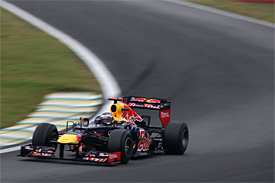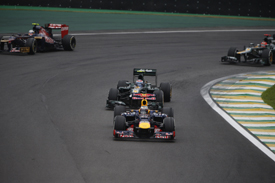| By Jonathan Noble | Thursday, November 29th 2012, 11:45 GMT |
 Formula 1 fans, the media and Ferrari themselves have pored over YouTube clips from the Brazilian Grand Prix that appeared to show Sebastian Vettel overtaking Jean-Eric Verge before the end of a yellow flag zone on lap four.
Formula 1 fans, the media and Ferrari themselves have pored over YouTube clips from the Brazilian Grand Prix that appeared to show Sebastian Vettel overtaking Jean-Eric Verge before the end of a yellow flag zone on lap four.
Yet although this short video was enough to prompt Ferrari to ask for clarification about the matter, detailed analysis of the incident by high level sources shows that the Red Bull driver was entirely within the regulations - and that there are no grounds for further investigation.
An FIA spokesman confirmed to AUTOSPORT that during the race itself there had been no report from a marshal about any overtaking under yellow flags, as would most likely have happened if a breach of the regulations had taken place.
Furthermore, an in-depth look of the warning lights and marshal's post set-up at the Interlagos circuit showed that Vettel's pass took place after he had passed a green flag.
Although the 'yellow' sector itself starts at a light panel just before Turn 3, and ends about 150m before Turn 4, the light panels are a supplement to the traditional flags and are rarely in the same location.
With the use of lights, due to increased visibility, the track can be divided up into fewer sectors as line-of-sight is not always needed between them. At Interlagos, there were 22 marshals' posts while the FIA installed 16 light panels, which means there was overlap in places. The warning lights are also linked to the display in the cockpit.
According to high level FIA sources, the light panel that was showing yellow for Pastor Maldonado's stricken Williams was shown 100 metres before the next marshal post, which was located near the exit of the pitlane.
At this marshal's post a green flag was being waved on lap four - at the same time as the light signal at Turn Four was displaying green.
The separation of these two posts was about 350 metres and FIA race director Charlie Whiting has made it clear to drivers since lights were introduced more than five years ago that when there are consecutive signals from both a flag and a light, it is the first one that counts.
 So if, for example, a yellow flag is displayed followed later by a yellow light, then the no overtaking area begins at the first yellow signal which would be the flag.
So if, for example, a yellow flag is displayed followed later by a yellow light, then the no overtaking area begins at the first yellow signal which would be the flag.
So, as happened in the Vettel case, if a driver is given a green warning flag followed by a green warning light, it is the first green that counts.
Vettel's pass took place after the first green flag but before the green light, so was wholly legitimate.
This was why race control was not informed of any potential infringement and the matter was never subject to a post-race inquiry by the stewards.
'); if (google_ads[0].type == "text") { for(i=0; i '; } s += '' + '' + '' + google_ads[i].line1 + '' + '' + google_ads[i].line2 + ' ' + google_ads[i].line3 + '
' + '' + '' + google_ads[i].visible_url + '
'; } } document.write(s); return; } google_ad_client = 'ca-haymarketgroup'; // substitute your client_id google_ad_channel = 'autosport'; google_ad_output = 'js'; google_max_num_ads = '3'; google_ad_type = 'text'; google_encoding = 'iso-8859-1'; google_safe = 'high'; google_adtest = 'off'; google_ad_section = 'default'; google_hints = 'Formula One, Formula 1, F1'; // -->
Source: http://www.autosport.com/news/report.php/id/104645
Rio de Janeiro Shark Week London 2012 closing ceremony Shark Week 2012 evelyn lozada UFC 150 Caster Semenya
No comments:
Post a Comment
Note: Only a member of this blog may post a comment.